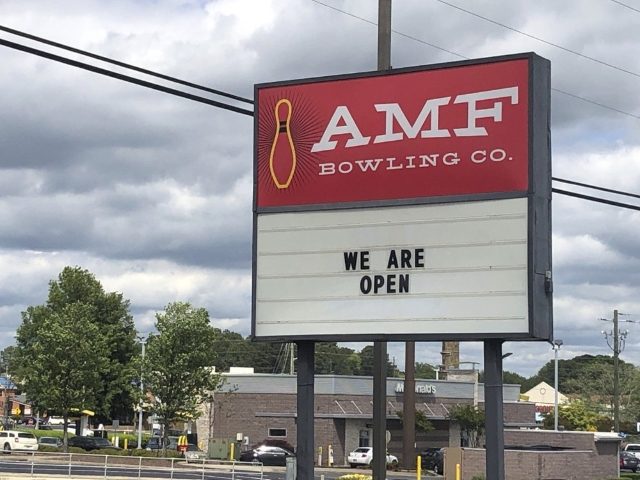CONYERS, Ga. (AP) — The sign outside the bowling alley in this bedroom community east of Atlanta contained a brief but compelling message Friday.
“We Are Open.”
Yep, they are open, but it’s hardly business as usual for a sport that’s always had a bit of an image problem.
Mockingly portrayed in movies such as “The Big Lebowski” and “Kingpin” as a leisurely pursuit for stoners and beer-bellied guys with bad comb-overs, bowling now finds itself in an uncomfortable spotlight as one of the businesses that Georgia allowed to reopen in the midst of the coronavirus pandemic.
The decision by Gov. Brian Kemp, who also cleared the way for barbershops, gyms, nail salons and tattoo parlors to get back to work, was met with ridicule from late-night comedians and condemnation closer to home, threatening the major strides bowling has made to be taken seriously as a sport.
Trevor Noah, host of “The Daily Show,” quipped that Kemp might as well urge “people to join a competitive sneezing league.”
Stephen Colbert of “The Late Show” jokingly asked, “Really? Bowling alleys? I’m going to go out on a limb here and say now is not the time for a sport where strangers stick their fingers inside the same three holes.” He then played not one, but two clips from “The Big Lebowki,” the 1998 cult hit where The Dude imbibes in his casual pursuit of rolling a few frames.
Then there was Atlanta Mayor Keisha Lance Bottoms, who simply griped, “There’s nothing essential about going to a bowling alley.”
True, but let’s show a little love to this sport of the common man and woman.
Like many industries in America and around the world, bowling has taken a huge financial blow because of lockdown measures designed to contain the highly contagious virus.
“It’s about as bad as it can get,” said Keith Hamilton, president of Chicago-based Luby Publishing that puts out the “Bowlers Journal International” each month. “Bowling centers have closed, and they closed during what we consider the peak season. All the tournaments are happening, national events are happening, you’ve got tournaments going on at the local level and leagues finishing up.”
Then there’s the trickle-down effect that spreads the financial misery far beyond the alleys, to companies such as Hamilton’s.
“When people aren’t bowling, they’re not buying products,” he went on. “So manufacturers are at a standstill. That affects me as a publisher. When manufacturers can’t sell product, they stop advertising.”
So, while it’s low-hanging fruit to ridicule bowling as nothing more than an excuse to drink beer and knock over things, that’s hardly fair to those who love the sport and pursue it at the highest levels.
“It’s so easy to poke fun at something you know very little about,” said Australia’s Jason Belmonte, winner of a record 13 major titles and one of the stars of the Professional Bowlers Association Tour. “The players out there are young and incredibly fit. The game has evolved from the 1950s and ’60s stereotype of the burger-eating, beer-drinking professional athlete.
“When you get an injection of reality,” he added, “that reality is very different from ‘Kingpin’ or ‘The Big Lebowski.’”
World Bowling, the sport’s international governing body, has been pushing for years to be included on the Olympic program — and it’s got a very strong case. The federation claims more than 100 million participants, some 10 million competitive players and approaching 150 member nations, making it far more popular than several sports that are part of the Summer Games.
While the United States is the dominant bowling country, there are plenty of top players from around the globe. More than 30 nations from every inhabited continent have claimed medals at the world championships, which are held every two years. Bowling is also part of the Pan-American Games and the Asian Games.
But now, because of a much-debated decision in the Deep South, it has again become the butt of the joke and a convenient target of criticism.
The AMF American Lanes in Conyers vowed to take major steps to prevent the virus from infecting its players and employees, including the hiring of an industrial cleaning crew, thorough sanitizing of balls and shoes, hand sanitizer stations throughout the complex, and maintaining an empty lane between groups to allow social distancing and prevent the sharing of balls.
A half-dozen cars were in the parking lot shortly after the center opened Friday, but the media — or any non-players, for that matter — were not allowed past the front desk. A worker wearing a mask and gloves referred all requests for interviews to a company spokesman.
Clearly, this is a nervous, awkward time for everyone involved with the sport.
Belmonte, who is locked down at his home in Orange, Australia, said his family owns three bowling centers Down Under. They were among the first business to shut down, and he expects they’ll be among the last to reopen.
He’s keeping an eye on the events in Georgia.
Hamilton is confident about the sport’s future, no matter how things turn out in this step toward a return to normal.
“We have taken a blow. The same thing happened to bowling in 1919 and ’20 when the Spanish flu hit,” he said.
“But every time a crisis has hit our country — or, in this case, the world — bowling has bounced back every time.”

COMMENTS
Please let us know if you're having issues with commenting.